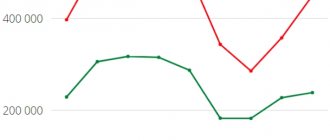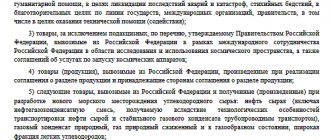Author of the article
Yuri Stanislavovich Burashnikov
Reading time: 6 minutes
AA
Exporting goods from Russia is a profitable but troublesome business. It is necessary to think through all stages of the transaction, study Russian legislation regarding the export activities of enterprises, delve into the features of different types of international transport, and first of all, deal with the documents for export from the Russian Federation.
We will tell you about the actions of an entrepreneur necessary to register cargo for export. We will provide a list of export documents: contract and certificate of origin, papers for transportation, confirmation of customs value and additional documentation.
List of documents required when exporting goods
The customs clearance procedure is a labor-intensive process, the successful outcome of which depends on many factors. It begins long before visiting customs and is accompanied by the preparation of the next package of documents.
Foreign economic contract
The document regulates the rights and obligations of the parties involved in the export. This is a kind of agreement on the supply of products, according to which the seller exports the goods from Russia, and the buyer receives and pays for it. The document is drawn up in writing and must reflect all delivery conditions - insurance, customs clearance, transportation, possible risks, etc.
Transaction passport
The document is required if the contract value of the transaction exceeds $50,000. The transaction passport regulates currency control of all export transactions. In this case, a document is drawn up for each transaction separately, and for currency control of the transaction the following set of documents is provided.
- Certificate of foreign exchange transactions.
- Certificate of supporting documents.
In some cases, for example, if, according to a foreign economic contract, payments are made periodically, then there is no need for these certificates.
Customs declaration
The export customs clearance procedure itself begins with the submission of a customs declaration, which includes a declaration of customs value and is filled out on paper or electronic media. At this stage of the process, it is advisable to use the services of a customs broker, who has a well-functioning mechanism for productive interaction with the Federal Customs Service authorities.
Invoice
Invoice (invoice) - which indicates the details of the seller, buyer, contract number, price characteristics of the goods and terms of delivery of products (according to the terms of the contract).
Transport documents
Depending on the method of cargo transportation, you must select one (or more) transport documents to submit.
- Consignment note – for road transport.
- International railway waybill – when sending cargo by rail.
- Bill of lading – in case of transportation by sea.
- Air waybill – when sending goods by air.
Documents on compliance with prohibitions and restrictions
In this case, we are talking about documents, the content of which is determined in accordance with the Commodity Nomenclature of Foreign Economic Activity. These can be sanitary and epidemiological reports, licenses, certificates of conformity, etc. – all documents that reflect the properties, quality of the cargo and provide a comprehensive description of its goods.
Certificate (or declaration) confirming the origin of the product
Manufacturer exporters submit cost estimates for goods, cost estimates for works (services), conclusions from the Federal executive authorities of the Russian Federation, etc., and documents required by the procedure.
If the exporter is not the manufacturer of the cargo, then he is obliged to submit a contract for the purchase of goods and documents confirming the fact of payment under the contract for the purchase of goods in Russia, as well as an extract from his personal account showing the cost of the transaction.
If the cargo being shipped is of foreign origin, then a cargo customs declaration with an agreement, invoice and payment documents for the imported goods will be required.
Documents confirming the classification code of products according to the Product Nomenclature
This package of documents includes a description of the product, its technical documentation and a quality certificate that justify the use of the specified HS code.
Documents on payment of customs duties
A customs order and a bank statement will be required if a customs declaration is submitted in writing. When declaring electronically, it will be enough to indicate the data of these documents in the declaration - indicate the number, date and amount of payment.
Document on the customs value of products
The list of these documents depends on the method used to determine the cost of the product. It may include a contract, constituent documents of the declarant, invoice, insurance, agreement with the carrier, waybill, etc.
At the same time, you need to be prepared for the fact that, according to Art. 67 of the Customs Code, customs may adjust the declared value of exported products. The decision is made on the basis of an audit, the results of which can be refuted by a number of additional documents. For example, provide customs with accounting or valuation reports, insurance, leasing agreements, rental agreements, etc.
Packing list
The document contains information about packaging, weight, number of pieces, and the shipment of products. The packing list is compiled for each product name separately.
Documents confirming the ownership of the cargo being shipped
The exporter, who is not the manufacturer of the goods, submits a purchase agreement for the exported cargo, an invoice for the purchased goods and payment documents. The exporter-manufacturer must present a calculation of the cost of goods certified by the chief accountant of his company.
Important!
When entrusting the procedure for customs clearance of exports to a customs broker (or other person), you must issue a power of attorney confirming his right to represent your interests when interacting with the Federal Customs Service.
Have any questions or problems with Export?
Don’t know how to solve them at the lowest cost? Contact EIG professionals, because solving foreign trade problems is our job!
Or contact us by phone,
Or via email
Calculation of VAT when exporting non-commodity goods to non-CIS countries
Next, using an example, we will consider different options for calculating VAT on the export of non-commodity goods that were purchased and sold starting from 07/01/2016.
The calculation of VAT on export supplies of non-commodity goods in 1C will differ depending on whether the 0% VAT rate is documented within 180 days or not.
- Export confirmed within 180 days
- Export not confirmed within 180 days
- Previously unconfirmed exports were confirmed later than 180 days
Registration of SF supplier
To register a supplier invoice (SF), you must indicate its number and date at the bottom of the Receipt document form (act, invoice) and click the Register .
The Invoice document received is automatically filled with data from the Receipt document (act, invoice) . Operation type code – “01” Receipt of goods, works, services.
If the document has the Reflect VAT deduction in the purchase book by date of receipt checkbox , then when it is posted, entries will be made to accept VAT for deduction.
VAT is deductible in the general manner, i.e. if the conditions are met (clause 2 of article 171 of the Tax Code of the Russian Federation, clause 3 of article 172 of the Tax Code of the Russian Federation):
- the goods must be used in activities subject to VAT;
- a correctly executed SF (UPD) is available;
- goods are accepted for accounting (clause 1 of article 172 of the Tax Code of the Russian Federation).
Separate VAT accounting is not maintained. The right to accept VAT as a deduction will arise for purchased goods, works, services, regardless of confirmation or non-confirmation of the 0% rate for the export of non-commodity goods (Clause 10 of Article 165 of the Tax Code of the Russian Federation).
Postings according to the document
Purchase Book report can be generated from the Reports – VAT – Purchase Book section. PDF
How to reflect exports in VAT returns in 1C 8.3
The VAT return reflects the amount of VAT deducted:
In Section 3 page 120 “Amount of VAT to be deducted”: PDF
- the amount of VAT accepted for deduction.
In Section 8 “Information from the purchase book”:
- invoice data, transaction type code "".
Sales of goods for export in 1C
Sales of goods for export in 1C 8.3 Accounting is prepared with the standard document Sales (act, invoice) transaction type Goods (invoice) in the section Sales - Sales - Sales (acts, invoices) - button Sales - Goods (invoice).
Let's look at the features of filling out the Implementation document (act, invoice) using the example:
- Agreement – an agreement with the buyer in USD currency, according to which goods are sold;
In the Prices form in the document, the exchange rate is set from the Currency directory on the date of reflection of the Sales document (deed, invoice) .
In the tabular part of the document, information about the goods sold (nomenclature, quantity, price, amount, etc.) is filled in:
- Price and Amount - the columns are filled in in currency, because the contract was concluded in USD;
- % VAT - 0%; VAT rate applied when selling goods for export.
Postings according to the document
The document generates transactions:
- Dt 90.02.1 Kt 41.01 – write-off of the cost of goods;
- Dt 62.22 Kt 62.21 – offset of the buyer’s advance at the exchange rate on the date of prepayment;
- Dt 62.21 Kt 90.01.1 – revenue from the sale of goods, where: the paid part is assessed at the exchange rate on the date of prepayment from the document Receipt to the current account ;
- unpaid portion - at the exchange rate on the date of sale from this document Sales (act, invoice) form Prices in the document .
Calculation of the ruble amount of proceeds from the sale of goods for export
date Name Amount, USD Well Amount, rub. January 17 Paid part 4 000 62 248 000 March 15th Unpaid portion 6 000 62 372 000 March 15th Total sum 10 000 620 000
Revenue in foreign currency is recalculated into rubles at the exchange rate of the Central Bank of the Russian Federation on the date of recognition of income, i.e. implementation, but the rate also depends on the payment procedure.
In our example, partial prepayment and postpayment are carried out. With this mixed form of payment, revenue in accounting and financial accounting is calculated (clause 9 of PBU 3/2006; clause 8 of Article 271 of the Tax Code of the Russian Federation):
- the paid portion is assessed at the exchange rate on the date of prepayment;
- the unpaid portion is assessed at the exchange rate on the date of sale.
The tax base for VAT in foreign currency is recalculated into rubles at the rate of the Central Bank of the Russian Federation on the date of sale (clause 3 of Article 153 of the Tax Code of the Russian Federation), the rate on the date of the advance is not taken into account. Therefore, revenue in accounting and NU may differ from the tax base for VAT.
When converting revenue from foreign currency into rubles for:
- BU and NU the exchange rate of the Central Bank of the Russian Federation is applied on the date of the advance and on the date of sale (clause 9 of PBU 3/2006, clause 8 of Article 271 of the Tax Code of the Russian Federation);
- To calculate the tax base for VAT, only the exchange rate of the Central Bank of the Russian Federation is used on the date of shipment of goods (clause 3 of Article 153 of the Tax Code of the Russian Federation).
The tax base for VAT is determined at the rate of the Central Bank of the Russian Federation on the date of shipment, so it will differ from the sales amount in accounting and tax accounting in ruble equivalent if:
- there was an advance payment;
- the date of transfer of ownership does not coincide with the date of shipment.
In our example, an advance was received, but the revenue in accounting and accounting records coincides with the VAT tax base, because the USD exchange rate on the date of the advance and on the date of sale is the same - 62 rubles. The exchange rate in the example is conditional.
The calculation of the tax base for VAT can be viewed in the register Ruble document amounts in currency .
Calculation of the tax base for VAT
| Name | Amount, USD | Well | Amount, rub. |
| Tax base for VAT | 10 000 | 62 | 620 000 |
Income tax return
In the income tax return:
The amount of revenue from the sale of goods for export is reflected in the income from sales:
Sheet 02 Appendix No. 1:
- page 010 “Proceeds from sales - total”, including: page 012 “... revenue from sales of purchased goods” PDF
The cost of goods sold is reflected in direct expenses:
Sheet 02 Appendix No. 2:
- p. 020 “Direct expenses of taxpayers...”, including: p. 030 “... cost of purchased goods sold” PDF
Documenting
The organization must approve the forms of primary documents, including the document for the sale of goods. In 1C, for internal document flow, a consignment note in the TORG-12 form is used.
The form can be printed by clicking the Print – Consignment note (TORG-12) document (act, invoice) . PDF
As a rule, a foreign buyer is issued:
- invoice-proforma;
- invoice;
- invoice (VAT-invoice).
Documents are prepared with translation into a foreign language. Such forms are not implemented in 1C and can be modified independently.
Benefits of working with us
General Import makes foreign economic activity simple and profitable for you. With us it is convenient, reliable and always effective. Among the undeniable advantages of the company:
- A rich experience. We have been working in the market for more than 10 years, processing 150 or more declarations per month. There is no place for administrative violations in our history - we use only legal schemes and provide only white closing documents;
- Expertise. Your transaction is accompanied by specialists with extensive experience in the ILO and DVTU.
- Wide range of services. We are responsible for expert support of your business in all areas - extensive consultations, customs clearance, document flow, interaction with authorities.
- Efficiency. We will calculate the customs value in just an hour, complete the declaration in 1-3 days, and calculate the cargo delivery routes that are “comfortable” for you in terms of price.
- Reliability. Our company's professional liability is insured. We work with any exported goods, including complex and project cargo.
- Great prices. We place a rate 2-4 times lower than the customs grid that our competitors use.
Documents for foreign trade
- An agreement with a foreign counterparty must contain all the terms of the transaction and rules, in particular regarding payment for goods and indirect costs incurred, as well as the moment of transfer of ownership (risks of loss) to the products.
- Invoice. There is no exact analogue of this document in Russian accounting. It is most similar to an invoice, but an invoice is used for value added tax purposes, while an invoice is used solely for accounting purposes. The document is used for customs and currency control. Contains information about the product - a full description of its characteristics and qualities, delivery conditions and details of the parties.
- Customs declaration – confirms the legality of the transaction for accounting purposes. It is filled out for each delivery and contains all the necessary information about the cargo, sender, recipient, and vehicle. It is required to be filled out, otherwise customs officers will not allow the goods through. The same thing will happen if you fill out a document with errors. Moreover, you need to fill out a declaration both when importing and exporting. The TD must contain a mark from the customs inspector.
- Payment and other documents, for example, licenses, product certificates, etc.
Important!
If a company has entered into an import contract worth more than 3 million rubles or an export contract worth more than 6 million rubles, it must provide copies of the agreement and details of the parties to the transaction to the authorized bank. You will also be asked to report any foreign currency payment over 200 thousand rubles, regardless of the contract amount. This measure replaces the transaction passport, which was issued previously.
Legislation on accounting for foreign economic transactions
Companies that conduct foreign economic activity, first of all, need to familiarize themselves with the basic law governing relationships with foreign counterparties - this is Federal Law 173-FZ of December 10, 2013 “On Currency Regulation and Currency Control.” When preparing and submitting reports and supporting documents, read the instructions of the Central Bank of the Russian Federation dated August 16, 2017 No. 181-I.
These two documents contain the basic rules for accounting for export and import transactions, and reporting on such transactions contains some innovations in terms of foreign economic activity.
Customs clearance of exports from Russia
Regardless of how long a company has been exporting, it cannot do without the help of specialists. After receiving the order and shipping the goods, a whole string of customs clearance follows. Unfortunately, filling out the paperwork is not such a simple process. Sometimes customs clearance of exports from Russia can take several hours.
In order to stimulate exports and support domestic producers, export duties are not levied on many goods produced in Russia. In addition, the cost of export services is often lower than for import activities due to the absence of corruption components. Nevertheless, there is a certain procedure that requires knowledge of customs legislation and the nuances of conducting export operations at Russian customs.
If you are interested in fast, unhindered customs clearance of exports from Russia, and are interested in the question of how to organize a convenient and profitable export, the specialists of the Bodrus broker will carry out all the necessary work for a reasonable fee. We are always interested in clients, so we are ready to help any export-oriented organizations from different regions of our country.
In addition to export issues, we resolve issues of registration of temporary import and export of goods. This is necessary when participating in foreign exhibitions or performing equipment repairs abroad.
Bodrus LLC also conducts:
- consulting on export, import or international transportation;
- customs escort;
- full legal support of the transaction;
- Foreign trade consulting in St. Petersburg.
Thanks to its favorable location in St. Petersburg, customs broker Bodrus has many contacts, connections and experience in reaching out to counterparties from different countries to organize exports from Russia. You can easily contact us and address any questions related to goods operations at customs. And we, in turn, guarantee high-quality and fast assistance at an affordable price. We consult for free.
Customs clearance of goods for export
Customs clearance of goods for export is a procedure regulated by the Customs Code of the Customs Union. The Customs Code sets out the rules for the export of goods outside the borders of the Customs Union for the purpose of sale. Conducting export activities requires a clear understanding of how products pass through customs, the specifics of FCS control, and the nuances of declaration. The standard preparation algorithm includes the following points:
- signing a foreign economic contract;
- collection of documentation for compliance with non-tariff regulation measures;
- opening a transaction passport at an authorized banking institution;
- concluding an agreement with a customs broker or logistics agency;
- payment of export customs duties;
- clearance of cargo in the customs zone.
In the process of customs clearance of goods for export, it is important to accurately select an intermediary who will directly interact with the Federal Customs Service authorities. The services of a representative are especially necessary for beginning exporters. The specialist will assist in collecting the documentation package. Documents for registration of export procedures require attention, professionalism and literacy. The timing of the passage of the Federal Customs Service largely depends on how correctly they are completed. The duration is affected by the type of registration, the presence or absence of electronic declaration, as well as the inspection, and the workload of customs.
Preparation of documents for export - where to go?
Actually, the specifics of the documents themselves tell the foreign trade participant where to go to get them completed.
- A foreign economic contract is drawn up directly between the exporter and the importer (purchaser of the cargo).
- To obtain a transaction passport and currency control certificates, contact a branch of the Bank of Russia.
- To justify the zero VAT rate, you will need to visit the tax authorities.
The export customs clearance procedure itself is carried out in the customs clearance and control department at the location of the shipper. In this case, you need to submit all of the above documents and perform three mandatory actions.
- 1. Present the cargo to customs control authorities.
- 2. Complete a customs declaration for export.
- 3. Make mandatory payments.
Next, for customs clearance you will need to go through the customs control procedure. This means that representatives of the Federal Customs Service can take any action against the exporter and the products he exports. For example.
- Oral survey.
- Inspection or inspection of cargo.
- Checking the markings.
- Receiving explanations. Etc.
Often, customs control actions are applied selectively, since it is impossible to thoroughly check each participant in foreign trade activities, because it paralyzes the work of customs. After all, checking everyone’s activities and load will require a lot of time and resources.
If you are also interested in importing to Russia and want to save your nerves and time, you can read our article - “What documents are needed to import goods to Russia?”
Accounting for the export of goods outside the Customs Union
Below is a table with questions related to the export of goods, tax and accounting of export transactions, which most often arise in the practical activities of exporters. For each of them, the table provides links to the relevant legal acts in which answers to them can be found. We are talking about accounting for the shipment and sale of goods for export outside the Customs Union.
A detailed analysis of accounting for the export of goods requires a large amount of information about the market, which the enterprise often does not have. Therefore, it is worth turning to professionals. Our information and analytical department is one of those that stood at the origins of the business of processing and adapting market statistics collected by federal departments.
Find out more
Quality in our business is, first of all, the accuracy and completeness of information. When you make a decision based on data that is, to put it mildly, incorrect, how much will your loss be worth? When making important strategic decisions, it is necessary to rely only on reliable statistical information. But how can you be sure that this information is reliable? You can check this! And we will provide you with this opportunity.
You can find out all the details by calling: +7 (495) 565-35-51 and 8 .
Request a call back
Accounting for export transactions in 1C 8.3 Accounting - step-by-step instructions
Attention! The VAT rate has been changed from 01/01/2019 from 18% to 20% and from 18/118 to 20/120.
The organization entered into an export contract with a foreign buyer Hotseason sp. zoo (Poland) for the supply of non-commodity goods in the amount of 10,000 USD.
On January 17, an advance payment of 40% in the amount of 4,000 USD was received from the buyer.
On February 12, non-commodity goods Fans (1,000 pcs.) worth RUB 400,020 were purchased from the supplier Aurora LLC. (including VAT 18%) for export shipment.
On March 13, advance customs payments were paid (customs duty 750 rubles).
On March 15, the buyer Hotseason sp. zoo goods were shipped for export: Fans (1,000 pcs.) worth 10,000 USD.
On March 15, customs declaration of goods was carried out, a mark on the customs declaration “Release permitted” was received and the goods were transferred to the carrier.
In accordance with the contract, the transfer of ownership of goods occurs at the moment of transfer of goods to the carrier, released under the customs export regime. Delivery basis FCA Moscow.
On March 25, the buyer of Hotseason sp. zoo transferred the balance of payment for the goods in the amount of 6,000 USD.
Conditional courses for example design:
- January 17, the exchange rate of the Central Bank of the Russian Federation is 62.00 rubles/USD;
- March 15, the exchange rate of the Central Bank of the Russian Federation is 62.00 rubles/USD;
- March 25, the exchange rate of the Central Bank of the Russian Federation is 63.00 rubles/USD;
- September 05, the rate of the Central Bank of the Russian Federation is 62.00 rubles/USD;
- October 1, the exchange rate of the Central Bank of the Russian Federation is 62.00 rubles/USD.
Export operations, export sales in 1C 8.3 step-by-step instructions →
| date | Debit | Credit | Accounting amount | Amount NU | the name of the operation | Documents (reports) in 1C | |
| Dt | CT | ||||||
| Purchase of goods and their sale for export | |||||||
| Receipt of advance payment from a foreign buyer | |||||||
| January 17 | 52 | 62.22 | 248 000 | 248 000 | Receipt of prepayment from the buyer to the transit account | Receipt to the bank account - Payment from the buyer | |
| Purchasing goods | |||||||
| 12th of February | 41.01 | 60.01 | 339 000 | 339 000 | 339 000 | Acceptance of goods for accounting | Receipt (act, invoice) - Goods (invoice) |
| 19.03 | 60.01 | 61 020 | 61 020 | Acceptance for VAT accounting | |||
| Registration of SF supplier | |||||||
| 12th of February | — | — | 400 020 | Registration of SF supplier | Invoice received for receipt | ||
| 68.02 | 19.03 | 61 020 | Acceptance of VAT for deduction | ||||
| — | — | 61 020 | Reflection of VAT deduction in the Purchase Book | Purchase Book report | |||
| Transfer of advance payment to customs | |||||||
| March 13 | 76.09 | 51 | 750 | 750 | 750 | Transfer of advance payment (customs duty) | Debiting from the current account - Other settlements with counterparties |
| Sales of goods for export | |||||||
| March 15th | 62.21 | 90.01.1 | 620 000 | 620 000 | 620 000 | Revenue from sales of goods | Sales (act, invoice) - Goods (invoice) |
| 90.02.1 | 41.01 | 339 000 | 339 000 | 339 000 | Write-off of the cost of goods | ||
| 62.22 | 62.21 | 248 000 | 248 000 | 248 000 | Advance offset | ||
| Issuance of export invoices in foreign currency (VAT rate 0%) | |||||||
| March 15th | — | — | 10 000 | Issuing invoices for shipment in foreign currency (VAT rate 0%) | Invoice issued for sales | ||
| Accounting for customs payments | |||||||
| March 15th | 44.01 | 76.09 | 750 | 750 | 750 | Customs duty is included in distribution costs | Manual entry - Operation |
| Receipt of payment from a foreign buyer | |||||||
| March 25 | 52 | 62.21 | 378 000 | 378 000 | Receipt of payment from the buyer to the transit account | Receipt to the bank account - Payment from the buyer | |
| 62.21 | 91.01 | 6 000 | 6 000 | 6 000 | Revaluation of receivables in foreign currency | ||






